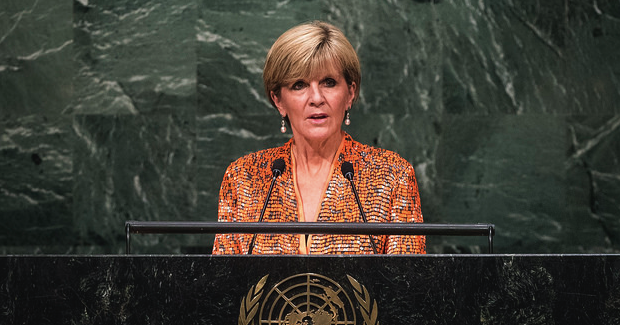Foreign Policy White Paper: Drafting a Legacy

The foreign policy white paper announced last week by Minister for Foreign Affairs Julie Bishop is an opportunity for the government to shape a legacy by articulating the contemporary Coalition view of Australia’s place in the world. The first such white paper in 13 years will be a substantial task for the new, but very able, Department of Foreign Affairs and Trade Secretary Frances Adamson.
The Minister for Foreign Affairs Julie Bishop has pointed out that the new white paper will be a “philosophical framework to guide Australia’s engagement, regardless of international events.” This causes one to wonder exactly how the white paper will guide Canberra’s foreign engagement and just why we have waited so long to release a new one. Indications are that it will be a white paper with a distinct political flavour, which is no bad thing. Bishop has already stated that “this will be a government generated document, it will go to Cabinet” suggesting that it will represent the world view of the Turnbull government. It will presumably have significant input from the foreign minister and will therefore comprise a large part of her personal legacy.
The white paper is an opportunity for the government to outline in detail the Coalition’s vision for Australian foreign policy in the 21st century. We already have a sense of this from Bishop’s various initiatives like the New Colombo Plan, an enterprise directly inspired by that pioneered by the Menzies government. Even a quick study of Bishop’s speeches, such as one she gave to the Lowy Institute in June, and her writings, like her article for the current edition of the Australian Journal of International Affairs, reveal the importance that she places on what she calls “economic diplomacy”. Bishop cites a raft of free trade agreements already in the bag (with more still in negotiation) as examples of this. While Bishop often refers to the importance of a stable global rules-based order for providing the necessary conditions for economic diplomacy, she has had less to say on the challenges that this order faces.
The white paper then is an opportunity to see if the government can outline in greater detail a set of guiding principles on foreign policy. It will also be a test to see if Australia’s interests can remain paramount in an environment dominated by an aggrieved China and a US potentially walking away from the Trans-Pacific Partnership and retreating into protectionism. The foreign policy white paper will also be a test for how Australia thinks about its alliance with the US. It would be encouraging to see a statement that manages to move beyond the mere platitudes that the recent defence white papers have offered. Moreover, it would be right to assert that while ANZUS is central to Australia’s foreign and strategic policy, it is a means to an end rather than an end in itself. All alliances are predicated on national interest; ANZUS is no different and articulating that won’t diminish its value.
In contrast to its Labor opponents, the Liberal Party is pretty remiss in honoring, let alone recording, its foreign policy legacy. The fact that many people believe that Australia’s engagement in Asia began with Gough Whitlam in 1972 says as much about the Liberals’ failure to counter the narrative as it does of Labor’s ability to shape it. However, the Liberal legacy in foreign affairs is a rich one. Years before Whitlam, Liberal ministers such as Harold Holt, Sir Garfield Barwick and Sir Paul Hasluck were travelling to Asia and forging important ties. The ANZUS Treaty, which remains Australia’s key alliance, would likely never have been signed without the persistence of Sir Percy Spender.
Although the concept of Australia as a middle power is one most associated with Labor, and particularly foreign ministers such as Doc Evatt and Gareth Evans, there is also a strong Coalition tradition of embracing middle power diplomacy. It is a tradition most clearly articulated by Barwick’s ambition for Australia to become a country that could use its own diplomacy to bridge divides between the great powers. It is also a tradition that could again be embraced by the Turnbull government in this white paper. Such an approach would allow Australia to clearly articulate its interests independently of the great powers.
During the Howard era the concept of middle power diplomacy fell out of favour with the Coalition, most probably because it was viewed as too strongly associated with Labor and the work of Gareth Evans. On the few occasions that she has mentioned the term, Bishop has tended to be dismissive of the idea of Australia as a middle power, pointing out that Australia is well above the middle in areas such as economy and defence spending. However, as a concept used to describe powers that are not considered great, yet are not small, the idea of Australia as a middle power still makes sense. In any case being a middle power seems to be as much about what a country does as what it is.
As the minister for foreign affairs approaches the task of delivering a new white paper with an eye to her legacy she may well be drawn to the Coalition’s tradition of middle power diplomacy.
Cam Hawker was an advisor to the Coalition in both opposition and government and was also previously president of the AIIA ACT. He is now with the University of NSW Canberra at ADFA.
This article is published under a Creative Commons Licence and may be republished with attribution.




